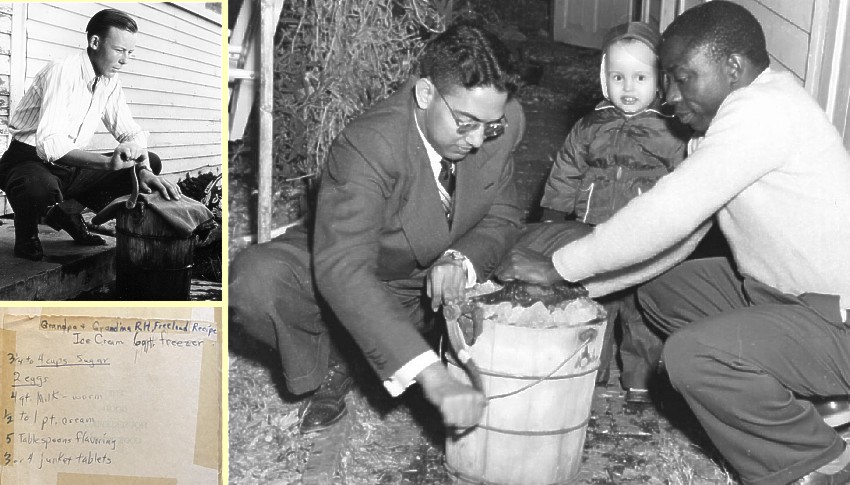Kansas Snapshots by Gloria Freeland - July 24, 2020
On a junket for junket
While I like ice cream all year round, I tend to associate it most closely with these warm days of summer. So I thought I'd write a
little about how that childhood connection arose.
Husband Art does not have this link and I think the difference has to do with his growing up in the city, while I grew up on a farm.
With a multitude of stores as well as a local dairy, whenever his family wanted ice cream - a favorite of his mother - his dad would
just buy some. But it wasn't as easily available on the farm and so we sometimes made our own.
Our family recipe - passed down from my Freeland grandparents and taped to the inside cover of Mom�s 1940s Good Housekeeping Cook Book
- included milk, cream, eggs, sugar, vanilla and rennet tablets.
Once Mom had mixed the ingredients, it was Dad's job to transform them into the cold treat we loved. The ice cream maker consisted of
a wooden bucket and a much smaller two-part galvanized canister. The ingredients went in the canister bottom. The top part had a paddle
connected through a small hole to a hand crank. When the paddle and canister top were placed on the bottom, the crank allowed the
ingredients to be stirred.
After placing the canister in the bucket, he packed ice between the two, added salt to promote melting, and then turned the handle
until the mixture inside was magically transformed.
He placed a towel on top to make sure the salty ice didn't get inside the canister. Sister Gaila remembers us kids sitting on the towel
to help keep the interior container in place while Dad cranked.
We made homemade ice cream several times every summer, and always when our California relatives came. Friend Bryce also had relatives
from there.
When our aunt and uncle came from California to visit, the whole Ferguson clan would gather at our farm for homemade ice cream. They
were basically celebrities coming all the way from California, so we served only the best ...
Cranking a maker was a long process and the closer the mixture was to completion, the harder it was to turn the crank. In later years,
the folks bought a unit with a motor, making that process much easier.
As the years went by and we siblings had our own children, we continued the ice cream tradition when we visited the farm. Hometown
friend Tom often brought his own ingredients and maker. That continued even after our parents moved to Manhattan. He said he enjoyed
those times because Mom would always have cookies or pie, and we�d have a good visit around the kitchen table.
Tom said that when he and his brother Charlie were young, they'd stick their fingers into the ice/salt combination to see how long
they could stand the intense cold. He also shared a story about an ice cream effort that went awry:
... My neighbor Calvin was amused once when he saw me making ice cream in the garage between our houses, and the machine just kept
running and running. I'd add the white granules from the sack every once in awhile then go do something else. It sure was taking a
long time to freeze. Calvin asked me, "is that salt you�re adding?" "Yes," I replied. After a couple of times he said "Tom, read what
it says on the sack." I did. It was sugar. ... If I had kept adding sugar, it never would have gotten cold enough for the mixture
to thicken to ice cream!
After sharing those stories with Art, he explained that when the salt combines with ice, it causes it to melt. Melting requires energy
and so it takes that energy from whatever it is in contact with - whether it be the canister of ingredients or little fingers. But
sugar does not have that effect.
With that mystery solved, I wondered what was in those tablets that were part of the ingredients. I read that rennet is an enzyme that
occurs naturally in the stomach of the young of some animals, such as calves, that causes the mother's milk to curdle, making it easier
to digest. It also is widely used in making cheese and causes a similar action with the milk in the ice cream mixture.
In 1874, a Danish chemist named Christian Hansen found a reliable way to make rennet and he made a good profit selling his product to
cheese makers. For centuries, the term junket had been used for a sweet treat such as ice cream. The English also called it curds and
whey, slip or rennet custard. Hansen saw selling his rennet to make ice cream as another business opportunity and marketed it as
junket rennet.
Reading this jogged my memory. I remember Mom sometimes calling the tablets "Junket Rennet," but never stopped to think about what
they were or where the name came from.
A check of the dictionary brought an additional bit of enlightenment. The online Merriam-Webster stated:
By the 16th century, junket had also come to mean "banquet." Apparently, traveling must have been involved to reach some junkets,
because eventually that term was also applied to pleasure outings or trips (whether or not food was the focus). Today, the word
usually refers ... to a trip made by a government official and paid for by the public ....
I'm no government official, but while writing this column, I did have a very pleasant mental junket down memory lane, while also
learning a few things. Now, since the word is also used to mean ice cream, I wonder if I can get Art to take me on a junket for junket!
